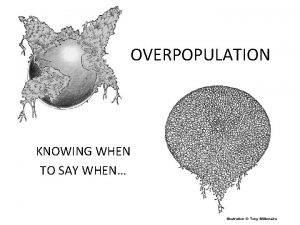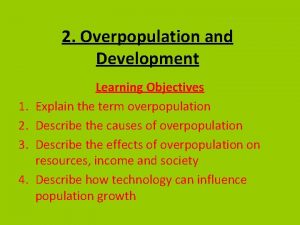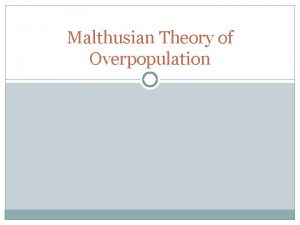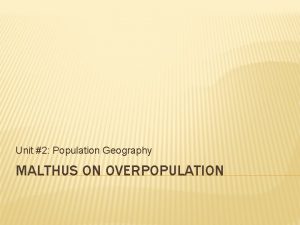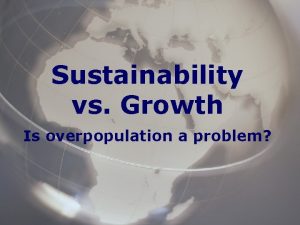OVERPOPULATION KNOWING WHEN TO SAY WHEN THOMAS MALTHUS













- Slides: 13

OVERPOPULATION KNOWING WHEN TO SAY WHEN…

THOMAS MALTHUS (1766 -1834) An English economist who argued that the world’s rate of population increase was outrunning development food supplies. His claim was that population increases geometrically but food supply increases arithmetically. He predicted that population growth would outstrip food resources unless “moral restraint” lowered CBRs or disease, famine, war or other disasters raised CDRs. The point of crisis is when an area exceeds its CARRYING CAPACITY (the maximum number of a species that an environment can sustain indefinitely)

NEOMALTHUSIANS Claim Malthus’s prediction is more pressing that ever because: a) He failed to predict the medical revolution and its ushering LDCs into stage 2, thus the gap between population and resources is wider in some countries than Malthus anticipated b) World population is outstripping other resources, not just food: Water Energy Farmland Clean Air The prediction: increased wars and violence in the future. “The fundamental problem [facing the planet today is that] there are too many people. For the planet’s sake, I hope we have bird flu or some other thing that will reduce the population, because otherwise we’re doomed. ” –Dr. Susan Blackmore, nueroscientist

ANTIMALTHUSIANS Claim that Malthus was a moron Claim that the world’s resources are not fixed but expanding Are possibilists and claim that humans can choose positive courses of action to expand food supply and other resources Man can develop new technologies, use existing resources more efficiently and substitute new resources for scarce ones Boserup and Kuznets: larger population is good… stimulates the economy and leads to more food production. More population, more customers and more thinkers/inventors. Julian Simon: Yeah, what they said. Marxists: the problem isn’t production/population, the problem is distribution (unfair society) Various leaders: more population is good because greater numbers = greater power.

REALITY World as a whole has plenty of food, but some areas do face shortages Malthus was pretty accurate about food production and its arithmetic growth However production has grown faster than anticipated recently due to better growing techniques, high yield seeds, expansion of cultivated land, fertilizer technology, etc. And food production has grown has outpaced NIR since 1950 ? Population did not quadruple between 1950 and 2000 as Malthus expected because cultural, technological and economic changes pushed more countries into stages 3 and 4 of the DT faster than he predicted Population has been growing at a slower pace since the 1970 s (down to 1. 3 from 1. 8 for the world) The question is WHY?

AMMUNITION FOR BOTH SIDES MALTHUS IS STILL RELEVANT MALTHUS IS IRRELEVANT THE EVIDENCE A. The population is rising/ has grown as Malthus predicted A. Pop growth not geometric/ or as Malthus predicted B. Food supply has increased, but it has not kept up with population increase or has grown as predicted by Malthus. B. Food supply has grown faster than Malthus predicted / the carrying capacity of most country’s land has increased C. There are other limiting factors on population in addition to food. C. Better modern ability to preserve food and/or distribute food to areas of need THE REASONS A. Limited use of contraception. Political policies, economic decisions, cultural beliefs that support population growth. Country is in Stage 2 and/or early Stage 3 of the Demographic Transition. B. Countries: fail to adopt agricultural innovation, b/c political policies, economic decisions, cultural beliefs. Convert farmland for urban use. Have practices that create environmental degradation (desertification, overgrazing, clear cutting, soil erosion, waterpollution). Convert of food crops to cash crops. Have high fuel prices that slow growth of food production and distribution. C. Because of resource overuse and/or environmental degradation, countries exceed their carrying capacity A. Expanded use of contraception. Countries have political policies, economic decisions, cultural beliefs that limit population growth. Countiry is in late Stages 3, 4, and/or 5 (declining birth rate) of the Demographic Transiition. B. Countries have: efficient farming (industrial tech). Green revolution techniques. Expanded Agricultural land. Humans with the ability to problem solve C. Improvements in methods of transportation. Improvements in food preservation

DECLINING NIR The NIR can decline for only two reasons: A HIGHER death rate (CDR) A LOWER birth rate (CBR) Which is a bad choice… In movies and in reality Which is what is happening… except for a few countries in Africa

LOWERING THE CBR Economic Development Approach (Pro-Natal) Family Planning Approach (Anti. Natal) Pro-natalism assigns a positive value to birth and espouses its free practice. This approach allows families free choice while also creating an environment where couples choose to have fewer babies. Anti-Natalism assigns a negative value to childbirth when childbirth contributes to overpopulation. There are more and less aggressive methods. Emphasizes reliance on economic development to push the social changes of stage 3 Wealthier communities have more to spend on health care, sanitation, education and programs that end up lowering the CBR If more women are in school and attend school longer, and if more women pursue careers, then they delay having children and have fewer children If more people are urban centered and work in industry, they have fewer children With improved health care and sanitation, IMR’s drop and since more infants survive, women have fewer children On the whole these methods seek to bring advances of the medical revolution, primarily birth control, to LDCs to lower CBRs in them. Less Aggressive Method: Voluntary family planning through distribution of birth control. Great success in Bangladesh (went from 6% to 58% usage in 25 years), Colombia, Morocco, Thailand. 75% of women in Asia and 66% in Latin America employ birth control, only 25% Africa. More Aggressive Methods: China’s One Child Policy Forced Sterilization (Nazi Germany)

HIGHER CDR Lower CBRs have reduced the NIR in most places, but some Sub-Saharan African countries have seen higher CDRs. The CDR usually grows through the spread of disease.

SPREAD OF INFECTIOUS DISEASE

EPIDEMIOLOGIC TRANSITION A model that identifies the distinct causes of death in each stage of the demographic transition The Demographic Transition Stage 1 • CBR is high, variable • CDR is high, variable • NIR in flux near zero • Population flat, low Stage 2 • CBR is high, variable • CDR drops steeply • NIR increases steeply • Population explodes Stage 3 • CBR drops steadily • CDR shallows drop • NIR drops steeply • Pop increase shallow Stage 4 • CBR & CDR meet low and level • NIR near zero • Population flat, high The Epidemiologic Transition Stage of pestilence and famine Stage of receding pandemics • Infectious and parasitic diseases cause death • Improved sanitation, nutrition, medicine in MDCs • Malthus’s natural checks • Medical Revolution in LDCs Stage of degenerative and human created diseases • Decrease infectious disease death • More age illnesses: cancer, heart disease Stage of delayed degenerative disease • Degenerative diseases linger • Medical technology extends lifespan overall

POSSIBLE STAGE 5 Demographic Transition Epidemiologic Transition Stage 5 Stage of reemergence of infectious and parasitic diseases CBR drops below CBR and begins period of irreversible population decline Some diseases reemerge and other new ones appear, the CDR begins to rise Caused by evolution, poverty, improved spread through travel

Some of the below cancers would be considered stage 2, others stage three and four. Try to predict their regions based on their descriptions WORLD CANCER RATES 4. PREDICT THE RATES 3. PREDICT THE RATES 2. PREDICT THE RATES 1. PREDICT THE RATES Where is cancer deadliest? The answer depends on regional differences in lifestyle, diet, and health care. Worldwide, lung cancer claims the most lives. Regional Patterns Breast cancer rates are higher in richer nations, where women give birth later in life and have fewer children. Colorectal cancer, linked to diets with more meat and processed foods in affluent nations, is less deadly when caught early. Cervical cancer kills more women in countries where the human papilloma virus is common and screening rare. Liver cancer is linked to the hepatitis B and C viruses, more prevalent in nations like China, South Korea, and Mongolia. GRAPHIC: OLIVER UBERTI, NGM STAFF; SOURCE: GLOBOCAN, INTERNATIONAL AGENCY FOR RESEARCH ON CANCER
 Thomas malthus overpopulation
Thomas malthus overpopulation Malthusian theory
Malthusian theory Thomas malthus industrial revolution
Thomas malthus industrial revolution Thomas robert malthus (1766-1834)
Thomas robert malthus (1766-1834) Thomas robert malthus
Thomas robert malthus David ricardo and thomas malthus
David ricardo and thomas malthus Thomas malthus carrying capacity
Thomas malthus carrying capacity Geophenom
Geophenom Not knowing is worse than knowing
Not knowing is worse than knowing The circle senator williamson
The circle senator williamson The population explosion
The population explosion Overpopulation defination
Overpopulation defination Statement of the problem about overpopulation
Statement of the problem about overpopulation Malthus
Malthus


